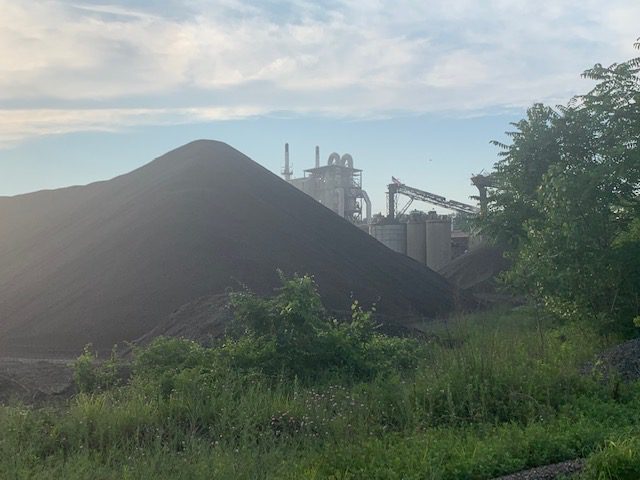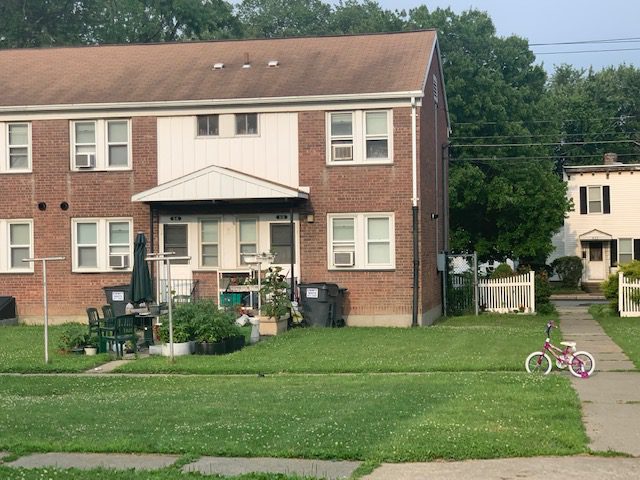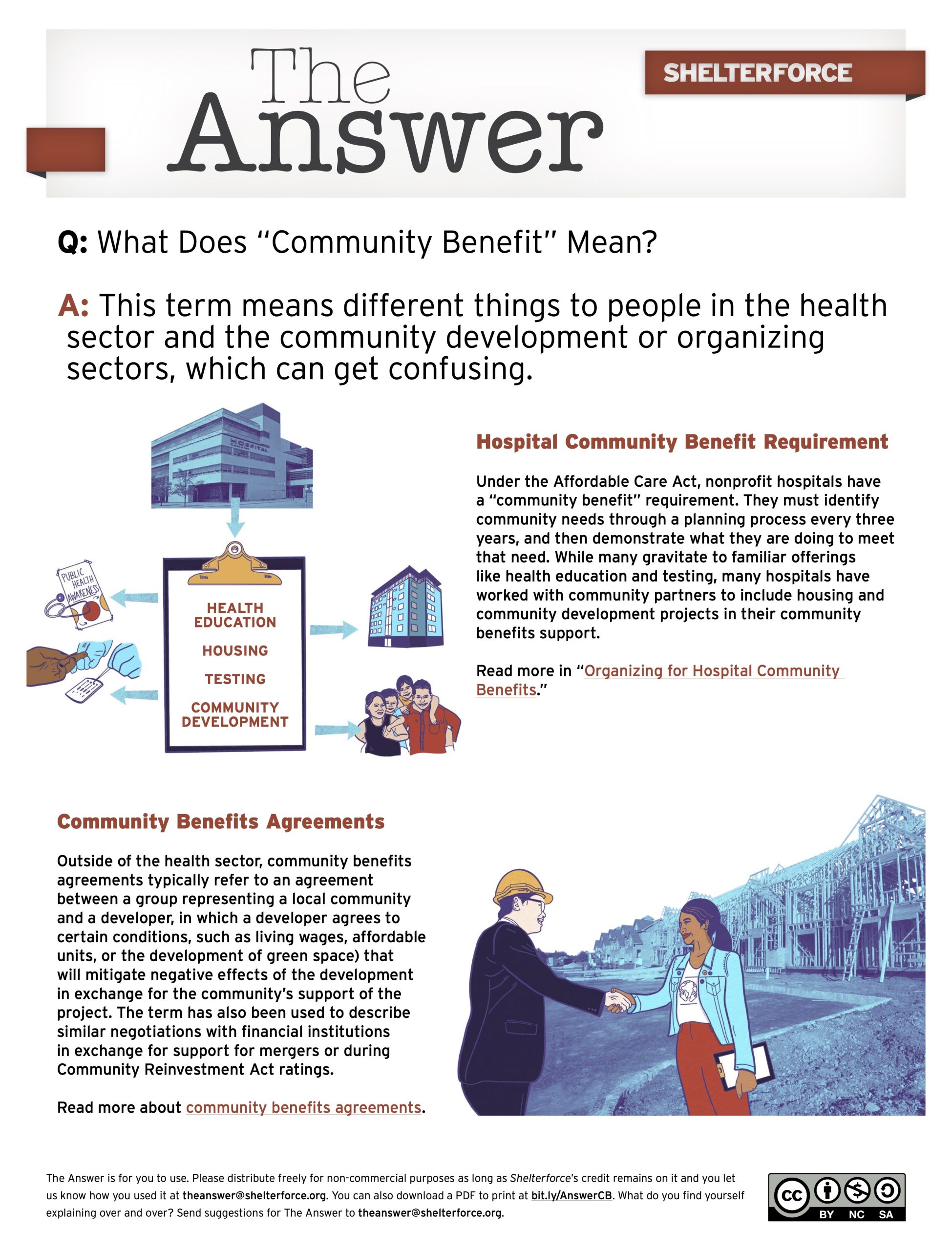
On the Norlite manufacturing campus in Cohoes, New York, mountains of fragmented grey shale loom over the surrounding terrain. On top of one of those mountains a sprinkler sends out a mist intended to prevent shale dust from spreading, a mitigation measure Norlite undertook in the face of mounting criticism. Photo courtesy of David King
Jennifer Malinowski doesn’t leave the house much anymore. Since moving in 2014 to Saratoga Sites, a public housing complex in Cohoes, New York, Malinowski and her two young children have developed major respiratory issues. She says her children have been diagnosed with asthma and she has undiagnosed breathing issues. And then there’s the smell.
“It stinks. The kids come inside after playing and they just stink. You can’t get away from it.”
Saratoga Sites is bordered by train tracks and a hazardous waste incinerator and manufacturing plant called Norlite, which makes a lightweight building material by superheating shale in a kiln. The company says that it uses “recycled fuels” to generate that heat, but what that means in practice a lot of the time is that it burns hazardous materials.
Malinowski is just one of many residents of the 70-unit complex who have complained of an overwhelming odor coming from Norlite, as well as particulates that coat their cars, clog their air conditioners, and sometimes, during upstate New York’s long winters, turn the snow black.
Malinowski wants to leave, but she can’t afford to live anywhere else. Nonetheless, she insists, “They should shut this place down. And they should shut Norlite down.”
Several residents agree with Malinowski on both counts. So, as it turns out, does the Cohoes Housing Authority (CHA), which runs Saratoga Sites. Mark Pasquale, chairperson of the housing authority, says CHA has begun the process of asking HUD to remove the property from its inventory and arrange for the relocation of its residents.
The public process began with a Zoom meeting on April 17, 2021, after months of work by the housing authority. CHA says Saratoga Sites should be shut down because it sits in an industrial zone about 100 feet from the plant, which generates an unhealthy amount of noise and has been cited for numerous violations for the last 30 years—from failing to report and monitor emissions properly, to exceeding emission safety levels, and more. (Even area residents who live within a mile of the plant have raised health concerns in the past, citing the number of households that have experienced various cancers, asthma, and other problems.)
Despite all this, getting residents out of the development will not be as simple as pointing out why it’s not safe to live there.
Public housing has often been built on or near contaminated land, leaving families—especially Black and Brown households—disproportionately affected by health and environmental threats.
An investigation released in January found that 9,000 federally subsidized housing sites are within a mile of the most contaminated places in the U.S., dubbed Superfund sites. Many of those sites—home to about 77,000 people—are directly adjacent to contaminated land, and remain open.
But there are, of course, other neighborhoods that are exposed to environmental and air-quality hazards that haven’t been identified for EPA-led cleanup—areas like those surrounding the Norlite plant.
It’s unclear how many other housing authorities or owners of those developments have proactively sought to relocate residents before being required to by regulators, as Cohoes Housing Authority is trying to do.
There’s also the question of what residents would lose from a move, as well as what they might gain. Aside from the Norlite plant, Saratoga Sites is well situated. It sits right off local Interstate 787, which connects the small suburb of Cohoes to larger cities like Troy and the state capital of Albany. It’s located across the street from a busy gas station and is right on a frequent public bus line, important as many residents don’t own a car.
Not Just New York
Kate Walz, senior staff attorney for the National Housing Law Project, worked with tenants of West Calumet Housing Project in East Chicago, Indiana, as they worked to relocate from their lead-poisoned homes. She is also a co-author of the Shriver Center on Poverty Law’s report Poisonous Homes: The Fight for Housing Justice in Federally Assisted Housing.
Walz says her clients wanted more time to move before HUD ultimately shuttered and demolished their development in 2016. A number of those tenants struggled for months to get landlords to accept their housing vouchers. Of the development’s 1,100 residents, one of the last people to move out was Akeeshea Daniels, who had moved into the complex with her children in 2004 when the youngest was just 1 month old. “It wasn’t until 2016 that I found out the home I lived in was poisoning my children,” Daniels wrote, describing her experience realizing she had to find somewhere else to live. Walz says pollution is so widespread in that neighborhood that many residents wound up moving into properties that were also contaminated. Daniels hoped to avoid that by moving out of East Chicago but found that housing authorities and landlords weren’t welcoming of people from her old neighborhood.

Saratoga Sites has 70 units, and sits in an industrial zone about 100 feet from the Norlite plant, which for 30 years has been cited for many violations. Photo courtesy of David King
Saratoga Sites, which resembles a series of boxy brick British row houses, is built around common outdoor space featuring grills and playground equipment. The complex also features a modest laundromat. Residents will tell you they aren’t happy with how any of those things are maintained, but there is no denying that the complex is in many ways convenient. It’s the surrounding Norlite site that makes the situation untenable for some tenants.
During the April virtual meeting with members of the Cohoes Housing Authority board, a consultant, and residents, some tenants welcomed the news that they would be relocated, but others were shocked and confused. Under the relocation plan, which requires HUD’s approval before closure of the site can proceed, residents would be given “tenant protection vouchers” to pay rent elsewhere, and they’ll be provided with as-yet undetermined relocation assistance. “If they knew about this, why did they put us here in the first place?” demanded one resident. “Environmental racism,” replied someone over the chat.
[RELATED: Pollution, Place, and the Unnecessary Tragedy of Premature Death]
According to an estimated timeline provided by CHA, the application to close Saratoga Sites was expected to be submitted to HUD in August. The process—from application approval to relocating residents—varies for each site, but CHA estimates it could take a minimum of six months.
“We can’t relocate anyone until HUD approves us for a shutdown and we are close to submitting that application,” Pasquale said in July.
As of Sept. 9, HUD had not received a demolition or disposition application from the Cohoes Housing Authority.
Press Secretary Meaghan Lynch says HUD urged the housing authority to conduct an environmental assessment of the site to determine whether a health hazard exists. That review is required to be submitted with the application. “HUD has not been informed by the Cohoes Housing Authority, the State of New York, or any environmental or health-related government entity that hazards are present at the site that threaten the health of the residents,” Lynch says.
Breathing Glass
Columbia University professor David Walker examined the dust that is so ubiquitous in the lives of Saratoga Sites residents and found it contains glass-like shards that can irritate the respiratory system. It was also recently revealed that in 2018 and 2019 Norlite burned over 2 million pounds of foam used to fight fires. That foam contains PFAS, thought to be a carcinogen. Exposure to PFAS may affect a person’s immune system, increase cholesterol levels, and decrease vaccine response in children.
In 2020, a group of Bennington College professors issued a study showing that they found PFAS contamination downwind from Norlite. The New York State Department of Environmental Conservation (DEC) countered with a study of its own later that year, stating it “found no clearly discernible pattern of aerial deposition that could be traced to Norlite’s operation.”
However, trust in the DEC is at a low in New York as the agency under former Gov. Andrew Cuomo appeared to act in a political manner, downplaying concerns from the EPA over contamination with PFAS by the manufacturing company Saint-Gobain. Jobs are a sensitive subject in upstate New York, as is government regulation of business. Norlite says it employs over 70 people at the Cohoes facility.
Joe Ritchie, a 20-something college student turned environmental activist who grew up in the complex with his mother, isn’t waiting around for HUD to approve relocation vouchers. He’s advocating for the DEC not to renew Norlite’s license to operate, which is up for review this year. He’s launched a campaign targeting local elected officials including Sens. Kirsten Gillibrand and Chuck Schumer and Rep. Paul Tonko, asking them through meetings, protests, and social media to call for the shuttering of the site and to expedite HUD’s decision-making process. Though he acknowledges moving residents out won’t solve their existing health problems, or be easy, “people can’t wait here while they get sicker,” he says.
Pasquale says he too feels major urgency. He understands concerns of people like Malinowski, who wonder if they will be able to find or afford a new apartment. Pasquale says CHA has no plans to build or buy new affordable units.
When HUD closed the West Calumet Housing Complex in Indiana in response to high levels of lead found in the soil, Akeeshea Daniels noted that: “All 1,100 residents were searching for housing with Section 8 vouchers at the same time. We had nowhere to go because so many landlords don’t take Section 8. HUD needs to do better.” New York state does have a source of income protection law, which makes it illegal to refuse vouchers, but the law is new and many landlords are not aware of it.
Malinowski says she’s already encountered that problem while searching for an apartment during the pandemic. She says landlords are actively rejecting people with vouchers.
“I look forward to having to tackle that problem,” Pasquale says, pointing to the fact that CHA plans to provide vouchers and assistance to cover moving expenses, and also plans to engage a relocation consultant to find current residents a new place to live. “This process is expensive but cost doesn’t come into play when people’s lives are at stake,” says Pasquale.
Walz says HUD must reconsider its approach to these situations and that discussions are happening about how to better serve people residing in dangerously polluted housing.
“From the public standpoint, what happened in these cases speaks to the core of environmental racism,” says Walz. “HUD’s response should be one that residents want and consistent with public health recommendations. Residents in the [East] Chicago case wanted the site cleaned up and the facility shut down. The community should be the beneficiaries once the cleanup happens. But what we see is that the cleanup finally happens once the Black and Brown families are gone. The beneficiaries end up being the gentrifiers, not the people who got sick.”
“Limiting Contamination”
On a hot summer day Ritchie walks past fencing that lines the railroad tracks that essentially serve as the development’s backyard.
He treks a few feet over a muddy stretch and up a small hill, and there the Norlite campus is revealed. Mountains of grey shale tower over the surrounding terrain. On top of one of those mountains sits what resembles a lawn sprinkler spritzing out a mist of water over the peaks of fragmented rock. The sprinkler is supposed to prevent shale dust from spreading, a mitigation measure Norlite undertook in the face of mounting criticism.
“This is how they say they are protecting us,” says Ritchie half mockingly, half in disbelief. Ritchie notes that the water spraying from the sprinkler comes from a mining pond that, according to state studies, is contaminated with pollutant perfluorooctane sulfonic acid (PFOS), exceeding the limit the DEC finds safe to drink. “They’re spraying this stuff that is contaminated to limit contamination. It’s a joke,” says Ritchie.
PFOS exposure has been linked to decreased vaccination response, thyroid disorders, pregnancy-induced hypertension and preeclampsia, and testicular and kidney cancer, according to the EPA.
Ritchie expressed his concerns to the DEC and Norlite’s parent company, but company officials dismissed those concerns in a response to the agency, saying the water is not used for drinking.
Over the last few years activists led by Ritchie have highlighted the dangers of Norlite’s activities.
The last weekend in July, residents of Saratoga Sites reported that a smelly mist had settled over their homes. Ritchie called the news media and local elected officials to come see what life is like under Norlite’s new mitigation measures. He says state Rep. John McDonald came by, but no news crews. “We were standing there and the assemblyman got sprayed in the face,” says Ritchie. “Now he knows what it’s like to live here. I think he understands.”





Comments